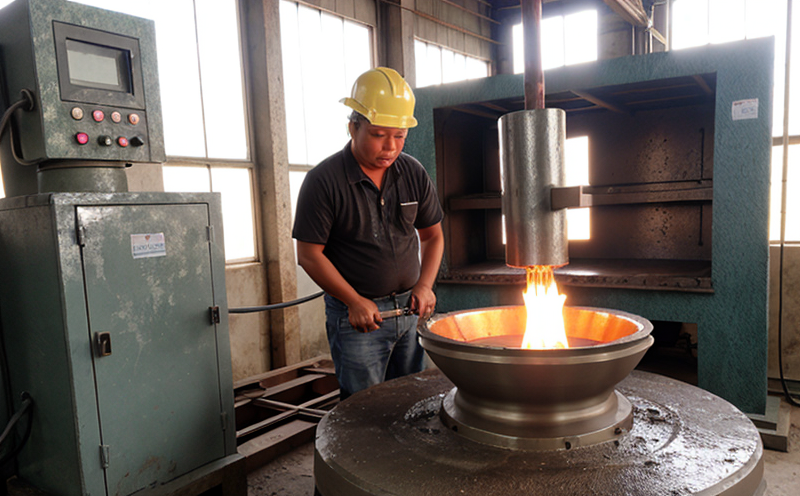ISO 8081 Microstructural Examination of Castings
The ISO 8081 standard provides a comprehensive framework for microstructural examination of castings. This method is crucial in ensuring the quality, reliability, and performance of metal castings used across various industrial sectors such as automotive, aerospace, and construction. The primary focus of this service is to examine the microstructure of castings to ensure adherence to specific standards and specifications.
The process involves several critical steps including sample preparation, mounting, grinding, polishing, etching, and examination using optical microscopy. Each step requires precise attention to detail to avoid compromising the integrity of the casting's microstructure. The aim is to identify any defects or inconsistencies that could affect the mechanical properties or performance of the casting.
One of the key aspects of this service is the use of advanced optics, such as polarized light and differential interference contrast (DIC) microscopy, which enhance the visibility of internal features within the metal matrix. This allows for a more detailed analysis of grain structure, phase composition, and other microstructural characteristics.
The examination process adheres strictly to ISO 8081 guidelines to ensure consistency and reliability in results. Compliance with these standards is essential for manufacturers seeking to meet regulatory requirements and maintain high-quality standards in their products.
For instance, the process can be particularly useful in identifying issues such as porosity, shrinkage cavities, and segregation, which are common defects in castings. By detecting these issues early on, manufacturers can take corrective actions during the manufacturing process to improve product quality.
The service also extends beyond mere examination; it involves providing detailed reports that outline findings and recommendations for improvement. These reports are invaluable tools for quality managers and compliance officers as they provide actionable insights into potential improvements in casting processes.
Why It Matters
The importance of microstructural examination cannot be overstated, especially within the industrial manufacturing sector where performance reliability is paramount. The examination process ensures that castings meet stringent quality standards set by international bodies like ISO and ASTM. This not only enhances product performance but also contributes significantly to safety and regulatory compliance.
For instance, in the automotive industry, high-performance parts such as engine blocks and transmission casings require precise microstructural analysis to ensure they can withstand rigorous operating conditions without failure. Similarly, aerospace components must adhere to strict specifications due to their critical role in ensuring safe flight operations.
The examination process also plays a crucial role in research and development (R&D) efforts aimed at improving casting processes and materials. By identifying areas for improvement, manufacturers can innovate and develop new technologies that enhance product performance and durability.
Moreover, the service contributes to sustainability by promoting efficient use of raw materials and reducing waste. By optimizing casting processes through detailed microstructural analysis, manufacturers can minimize defects and improve yield rates, thus conserving resources and lowering environmental impact.
Environmental and Sustainability Contributions
The ISO 8081 microstructural examination process is inherently aligned with sustainability goals. By optimizing casting processes through detailed examination of castings, manufacturers can minimize waste and improve efficiency. This leads to reduced energy consumption during production and lower greenhouse gas emissions.
Additionally, the service supports sustainable development by enabling the use of recycled materials in casting processes. By identifying defects early on, manufacturers can make informed decisions about material selection and process optimization, which ultimately reduces the need for virgin raw materials.
The examination also plays a role in promoting circular economy principles by encouraging the reuse and recycling of defective castings that can be remanufactured or repurposed after thorough analysis. This approach not only conserves resources but also extends product life cycles, reducing waste and environmental impact.
Use Cases and Application Examples
| Use Case/Example | Description |
|---|---|
| Automotive Engine Blocks | Detailed examination of engine blocks ensures they can withstand high temperatures and pressures without failure, enhancing vehicle performance and reliability. |
| Aerospace Propeller Blades | Analysis of propeller blades helps ensure they meet stringent safety standards for flight operations, reducing the risk of accidents. |
| Mining Equipment Parts | Microstructural examination of mining equipment parts ensures durability and longevity under extreme working conditions, minimizing downtime and maintenance costs. |
| Bicycle Frame Manufacturing | Detailed analysis of bicycle frames helps manufacturers ensure consistent quality in the production process, enhancing product performance and customer satisfaction. |
| Construction Machinery Castings | Examination of construction machinery castings ensures they can withstand heavy loads and harsh environments without failure, enhancing safety and productivity. |
| Military Hardware Components | Detailed analysis of military hardware components helps ensure they meet strict performance and reliability standards for critical operations. |
| Consumer Electronics Cases | Microstructural examination of consumer electronics cases ensures durability and long-lasting performance, enhancing customer satisfaction. |
| Medical Device Components | Detailed analysis of medical device components helps ensure they meet strict safety and performance standards for healthcare applications. |
The use cases listed above highlight the versatility of ISO 8081 microstructural examination in various industries. By ensuring that castings meet stringent quality standards, this service contributes to enhancing product performance, reliability, and sustainability across multiple sectors.





